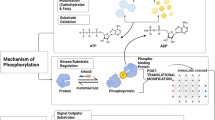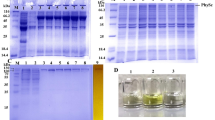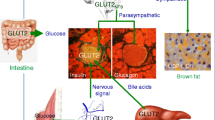Abstract
Xenopus laevis endure substantial dehydration which can impose hypoxic stress due to impaired blood flow. Tissues may increase reliance on anaerobic glycolysis for energy production making the regulation of hexokinase (HK) important. We investigated the enzymatic properties and phosphorylation state of purified HK from the muscle of control and dehydrated (30 % total body water lost) frogs. Bioinformatic tools were also applied to analyze the structural implication of HK phosphorylation in silico. HK from the muscle of dehydrated frogs showed a significantly higher Vmax (3.4-fold) and Km for glucose (2.4-fold) compared with control HK but the Km for ATP was unaltered. HK from dehydrated frogs also showed greater phosphoserine content (20 % increase) and lower phosphothreonine (22 % decrease) content compared to control HK. Control HK had a higher melting temperature (Tm = 61.9 °C) than from dehydrated (Tm = 54.2 °C) frogs when thermostability was tested using differential scanning fluorimetry. In silico phosphorylation of a Xenopus HK caused alterations in active site binding, corroborating phosphorylation as the probable mechanism for kinetic regulation. Physiological consequences of dehydration-induced HK phosphorylation appear to facilitate glycolytic metabolism in hypoxic situations. Augmented HK function increases the ability of Xenopus to overcome compromised oxidative phosphorylation associated with ischemia during dehydration.






Similar content being viewed by others
Abbreviations
- DEAE:
-
Diethylaminoethyl
- EGTA:
-
Ethylene glycol tetraacetic acid
- EDTA:
-
Ethylenediaminetetraacetic acid
- G6PDH:
-
Glucose-6-phosphate dehydrogenase
- HK:
-
Hexokinase
- LDH:
-
Lactate dehydrogenase
- MOE:
-
Molecular operating environment
- PMSF:
-
Phenylmethylsulfonyl fluoride
- PPSP:
-
Prediction of PK-specific phosphorylation
- SDS-PAGE:
-
Sodium dodecyl sulfate polyacrylamide gel electrophoresis
References
Romspert AP (1976) Osmoregulation of African clawed frog, Xenopus laevis, in hypersaline media. Comp Biochem Phys A 54:207–210
Churchill TA, Storey KB (1995) Metabolic effects of dehydration on an aquatic frog, Rana pipiens. J Exp Biol 198:147–154
Hillman SS (1978) The roles of oxygen delivery and electrolyte levels in the dehydrational death of Xenopus laevis. J Comp Phys 128:169–175
Malik A, Storey KB (2009) Activation of extracellular signal-regulated kinases during dehydration in the African clawed frog, Xenopus laevis. J Exp Biol 212:2595–2603
Eckenhoff RG, Dodia C, Tan Z, Fisher AB (1992) Oxygen-dependent reperfusion injury in the isolated rat lung. Can J Appl Physiol 72:1454–1460
Hermes-Lima M, Storey JM, Storey KB (2001) Antioxidant defenses and animal adaptation to oxygen availability during environmental stress. Cell Mol Res Stress 2:263–287
Merkle S (1989) Long-term starvation in Xenopus laevis Daudin—III. Effects on enzymes in several tissues. Comp Biochem Phys B 94:783–788
Merkle S, Hanke W (1988) Long-term starvation in Xenopus laevis Daudin—II. Effects on several organs. Comp Biochem Phys A 90:491–495
Onishi Y, Hirasaka K, Ishihara I, Oarada M, Goto J, Ogawa T, Suzue N, Nakano S, Furochi H, Ishidoh K, Kishi K, Nikawa T (2005) Identification of mono-ubiquitinated LDH-A in skeletal muscle cells exposed to oxidative stress. Biochem Biophys Res Commun 336:799–806
Derouiche A, Cousin C, Mijakovic I (2012) Protein phosphorylation from the perspective of systems biology. Curr Opin Biotech 23:585–590
Klumpp S, Krieglstein J (2005) Reversible phosphorylation of histidine residues in vertebrate proteins. BBA 1754:291–295
Storey KB (2015) Regulation of hypometabolism: insights into epigenetic controls. J Exp Biol 218:150–159
Storey KB, Storey JM (1990) Metabolic rate depression and biochemical adaptation in anaerobiosis, hibernation and estivation. Q Rev Biol 65:145–174
Katzenback BA, Dawson NJ, Storey KB (2014) Purification and characterization of a urea sensitive lactate dehydrogenase from the liver of the African clawed frog, Xenopus laevis. J Comp Phys B 184:601–611
Brooks SPJ (1992) A simple computer program with statistical tests for the analysis of enzyme kinetics. Biotechniques 13:906–911
Brooks SPJ (1994) A program for analyzing enzyme rate data obtained from a microplate reader. Biotechniques 17:1154–1161
Bradford MM (1976) A rapid and sensitive method for the quantitation of microgram quantities of protein utilizing the principle of protein-dye binding. Anal Biochem 72:248–254
Biggar KK, Dawson NJ, Storey KB (2012) Real-time protein unfolding: a method for determining the kinetics of native protein denaturation using a quantitative real-time thermocycler. Biotechniques 53:231
Blom N, Gammeltoft S, Brunak S (1999) Sequence and structure-based prediction of eukaryotic protein phosphorylation sites. J Mol Biol 294:1351–1362
Xue Y, Li A, Wang L, Feng H, Yao X (2006) PPSP: prediction of PK-specific phosphorylation site with Bayesian decision theory. BMC Bioinform 7:163
Rosano C, Sabini E, Rizzi M, Deriu D, Murshudov G, Bianchi M, Serafini G, Magnani M, Bolognesi M (1999) Binding of non-catalytic ATP to human hexokinase I highlights the structural components for enzyme-membrane association control. Structure 7:1427–1437
Niesen FH, Berglund H, Vedadi M (2007) The use of differential scanning fluorimetry to detect ligand interactions that promote protein stability. Nat Protoc 2:2212–2221
Mulichak AM, Wilson JE, Padmanabhan K, Garavito RM (1998) The structure of mammalian hexokinase-1. Nat Struct Biol 5:555–560
Edwards JR, Jenkins JL, Swanson DL (2004) Seasonal effects of dehydration on glucose mobilization in freeze-tolerant chorus frogs (Pseudacris triseriata) and freeze-intolerant toads (Bifo woodhousii and B. cognatus). J Exp Zool A Comp Exp Biol 301:521–531
Churchill TA, Storey KB (1993) Dehydration tolerance in wood frogs: a new perspective on development of amphibian freeze tolerance. Am J Physiol Regul Integr Comp Physiol 265:R1324–R1332
Churchill TA, Storey KB (1994) Effects of dehydration on organ metabolism in the frog, Pseudacris crucifer: hyperglycemic responses to dehydration mimic freezing-induced cryoprotectant production. J Comp Phys B 164:492–498
Abnous K, Storey KB (2008) Skeletal muscle hexokinase: regulation in mammalian hibernation. Mol Cell Biochem 319:41–50
Dawson NJ, Storey KB (2012) Regulation of tail muscle hexokinase in the anoxia-tolerant freshwater crayfish, Orconectes virilis. HOAJ Biol 1:851–859
Dieni CA, Storey KB (2011) Regulation of hexokinase by reversible phosphorylation in skeletal muscle of a freeze-tolerant frog. Comp Biochem Physiol B 159:236–243
Janssens PA (1964) Urea production and transaminase activity in Xenopus laevis Daudin. Comp Biochem Physiol 13:217–224
Wray S, Wilkie DR (1995) The relationship between plasma urea levels and some muscle trimethylamine levels in Xenopus laevis: a 31P and 14N nuclear magnetic resonance study. J Exp Biol 198:373–378
Balinsky JB, Choritz EL, Coe CGL, van der Schans GS (1967) Amino acid metabolism and urea synthesis in naturally aestivating Xenopus laevis. Comp Biochem Physiol 22:59–68
Hillman SS (1980) Physiological correlates of differential dehydration tolerance in anuran amphibians. Copeia 1980:125–129
Miyamoto S, Murphy AN, Brown JH (2008) Akt mediates mitochondrial protection in cardiomyocytes through phosphorylation of mitochondrial hexokinase-II. Cell Death Differ 15:521–529
Zuurbier CJ, Smeele KM, Eerbeek O (2009) Mitochondrial hexokinase and cardioprotection of the intact heart. J Bioenerg Biomembr 41:181–185
Waskova-Arnostova P, Elsnicova B, Kasparova D, Hornikova D, Kolar F, Novotny J, Zurmanova J (2015) Cardioprotective adaptation of rats to intermittent hypobaric hypoxia is accompanied by the increased association of hexokinase with mitochondria. J Appl Physiol 119:1487–1493
Lynch RM, Fogarty KE, Fay FS (1991) Modulation of hexokinase association with mitochondria analyzed with quantitative three-dimensional confocal microscopy. J Cell Biol 112:385–395
Rose IA, Warms JV (1967) Mitochondrial hexokinase release, rebinding, and location. J Biol Chem 242:1635–1645
Lynch RM, Carrington W, Fogarty KE, Fay FS (1996) Metabolic modulation of hexokinase association with mitochondria in living smooth muscle cells. Am J Physiol Cell Physiol 270:C488–C499
Idris I, Gray S, Donnelly R (2001) Protein kinase C activation: isozyme-specific effects on metabolism and cardiovascular complications in diabetes. Diabetologia 44:659–673
Holden CP, Storey KB (1997) Second messenger and cAMP-dependent protein kinase responses to dehydration and anoxia stresses in frogs. J Comp Physiol B 167:305–312
Narayanan A, Jacobson MP (2009) Computational studies of protein regulation by post-translational phosphorylation. Theory Simul Macromol Assem 19:156–163
Acknowledgments
Thanks to JM Storey for editorial review of the manuscript, to Dr. Alex Wong for bioinformatics guidance and to Dr. Neal J. Dawson and Dr. Ryan A. V. Bell for generally teaching me everything. This research was supported by a discovery grant (#6793) from the Natural Sciences and Engineering Research Council (NSERC) of Canada to KBS and the Canada Research Chairs program.
Author information
Authors and Affiliations
Corresponding author
Electronic supplementary material
Below is the link to the electronic supplementary material.
Rights and permissions
About this article
Cite this article
Childers, C.L., Storey, K.B. Post-translational Regulation of Hexokinase Function and Protein Stability in the Aestivating Frog Xenopus laevis . Protein J 35, 61–71 (2016). https://doi.org/10.1007/s10930-016-9647-0
Published:
Issue Date:
DOI: https://doi.org/10.1007/s10930-016-9647-0




